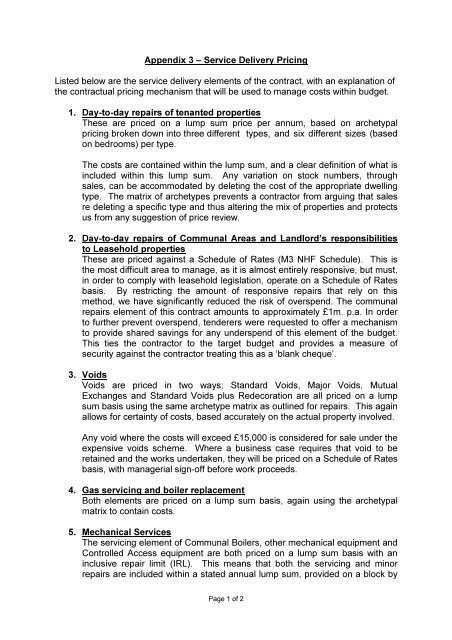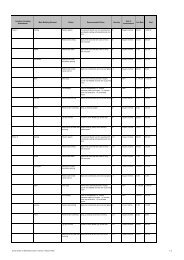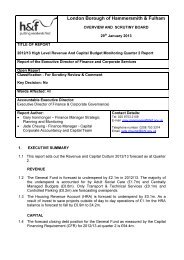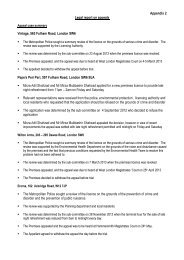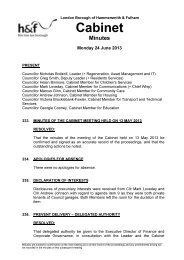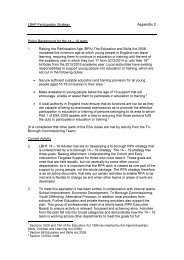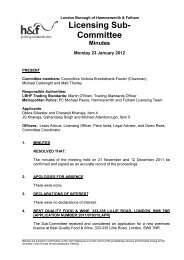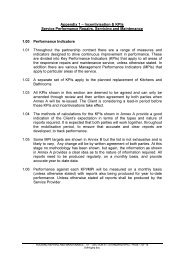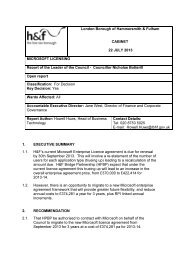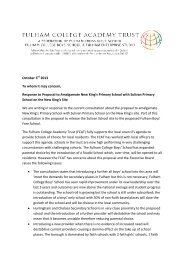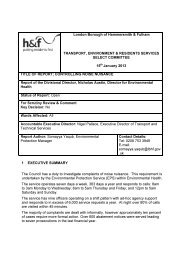Appendix 3 â Service Delivery Pricing Listed below are the service ...
Appendix 3 â Service Delivery Pricing Listed below are the service ...
Appendix 3 â Service Delivery Pricing Listed below are the service ...
Create successful ePaper yourself
Turn your PDF publications into a flip-book with our unique Google optimized e-Paper software.
<strong>Appendix</strong> 3 – <strong>Service</strong> <strong>Delivery</strong> <strong>Pricing</strong><br />
<strong>Listed</strong> <strong>below</strong> <strong>are</strong> <strong>the</strong> <strong>service</strong> delivery elements of <strong>the</strong> contract, with an explanation of<br />
<strong>the</strong> contractual pricing mechanism that will be used to manage costs within budget.<br />
1. Day-to-day repairs of tenanted properties<br />
These <strong>are</strong> priced on a lump sum price per annum, based on archetypal<br />
pricing broken down into three different types, and six different sizes (based<br />
on bedrooms) per type.<br />
The costs <strong>are</strong> contained within <strong>the</strong> lump sum, and a clear definition of what is<br />
included within this lump sum. Any variation on stock numbers, through<br />
sales, can be accommodated by deleting <strong>the</strong> cost of <strong>the</strong> appropriate dwelling<br />
type. The matrix of archetypes prevents a contractor from arguing that sales<br />
re deleting a specific type and thus altering <strong>the</strong> mix of properties and protects<br />
us from any suggestion of price review.<br />
2. Day-to-day repairs of Communal Areas and Landlord’s responsibilities<br />
to Leasehold properties<br />
These <strong>are</strong> priced against a Schedule of Rates (M3 NHF Schedule). This is<br />
<strong>the</strong> most difficult <strong>are</strong>a to manage, as it is almost entirely responsive, but must,<br />
in order to comply with leasehold legislation, operate on a Schedule of Rates<br />
basis. By restricting <strong>the</strong> amount of responsive repairs that rely on this<br />
method, we have significantly reduced <strong>the</strong> risk of overspend. The communal<br />
repairs element of this contract amounts to approximately £1m. p.a. In order<br />
to fur<strong>the</strong>r prevent overspend, tenderers were requested to offer a mechanism<br />
to provide sh<strong>are</strong>d savings for any underspend of this element of <strong>the</strong> budget.<br />
This ties <strong>the</strong> contractor to <strong>the</strong> target budget and provides a measure of<br />
security against <strong>the</strong> contractor treating this as a ‘blank cheque’.<br />
3. Voids<br />
Voids <strong>are</strong> priced in two ways; Standard Voids, Major Voids, Mutual<br />
Exchanges and Standard Voids plus Redecoration <strong>are</strong> all priced on a lump<br />
sum basis using <strong>the</strong> same archetype matrix as outlined for repairs. This again<br />
allows for certainty of costs, based accurately on <strong>the</strong> actual property involved.<br />
Any void where <strong>the</strong> costs will exceed £15,000 is considered for sale under <strong>the</strong><br />
expensive voids scheme. Where a business case requires that void to be<br />
retained and <strong>the</strong> works undertaken, <strong>the</strong>y will be priced on a Schedule of Rates<br />
basis, with managerial sign-off before work proceeds.<br />
4. Gas servicing and boiler replacement<br />
Both elements <strong>are</strong> priced on a lump sum basis, again using <strong>the</strong> archetypal<br />
matrix to contain costs.<br />
5. Mechanical <strong>Service</strong>s<br />
The servicing element of Communal Boilers, o<strong>the</strong>r mechanical equipment and<br />
Controlled Access equipment <strong>are</strong> both priced on a lump sum basis with an<br />
inclusive repair limit (IRL). This means that both <strong>the</strong> servicing and minor<br />
repairs <strong>are</strong> included within a stated annual lump sum, provided on a block by<br />
Page 1 of 2
lock basis, which allows for any future changes through regeneration<br />
schemes. The level of <strong>the</strong> IRL is £450 for communal boilers and mechanical<br />
equipment and £150 for Controlled Access. These arrangements <strong>are</strong><br />
identical to <strong>the</strong> current mechanisms and thus <strong>are</strong> already accepted by<br />
leaseholders.<br />
Major repairs over and above <strong>the</strong> IRL <strong>are</strong> costed on a Schedule of Rates with<br />
orders approved by an officer with appropriate delegation, and with costs<br />
known at <strong>the</strong> time of commitment.<br />
6. Fire Safety Works<br />
These <strong>are</strong> costed on a schedule of rates basis. These works <strong>are</strong> ordered on<br />
a block by block basis in response to <strong>the</strong> observations in <strong>the</strong> Fire Risk<br />
Assessments, or as a result of enforcement notice. Cost control is achieved<br />
by <strong>the</strong> ordering officer, <strong>the</strong> extent of <strong>the</strong> works being limited by <strong>the</strong> ordered<br />
items, and <strong>the</strong> cost being known at <strong>the</strong> time of commitment.<br />
7. Asbestos removal works<br />
These <strong>are</strong> costed on a schedule of rates basis, as <strong>the</strong> extent of works<br />
required is now comparatively light. The bulk of removal works in communal<br />
<strong>are</strong>as will have been completed by <strong>the</strong> end of March 2013, any fur<strong>the</strong>r<br />
removal will only apply to <strong>the</strong> occasional void. Justification for such works will<br />
be <strong>the</strong> basis of an Asbestos survey of <strong>the</strong> property, and individual costs will be<br />
known at <strong>the</strong> time of commitment.<br />
8. Planned Works (Kitchens and Bathrooms)<br />
These <strong>are</strong> priced on a basket of lump sum rates; schemes will be planned in<br />
advance, and costed using <strong>the</strong> lump sum prices. The size of each scheme<br />
will be designed to meet pre-determined budgets, and <strong>the</strong> cost will be known<br />
at <strong>the</strong> time of commitment<br />
9. Annual indexation<br />
The contract allows for annual indexation using <strong>the</strong> government’s Consumer<br />
Prices Index produced by <strong>the</strong> National Statistics Office. This allows for full<br />
transp<strong>are</strong>ncy with leaseholders, and also prevents any undue premium being<br />
applied by contractors when considering <strong>the</strong> risk of a longer term fixed price.<br />
By allowing for inflationary increases, we <strong>are</strong> confident in achieving <strong>the</strong> most<br />
economical base price at tender stage. Projections by Building Cost<br />
Information <strong>Service</strong> CIS of <strong>the</strong> RICS and QS consultants Sweett Group<br />
indicate that tender and construction price rises over <strong>the</strong> next four to five<br />
years will outstrip inflation. Limiting annual indexation to CPI will protect us<br />
from any over recovery by <strong>the</strong> contractor.<br />
Page 2 of 2


